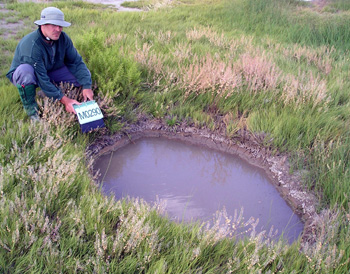BIOGEOCHEMICAL CYCLING : |
|||||||||||||||||||||||||||||||||||||||||||||||||||||||||||||||||||||||||||||||||||||||||||||||||||||||||||
Enrichment Culture and Isolation of Novel Organisms
Principal Investigator: Tim Magnuson (ISU) Microorganisms involved in reductive biogeochemical processes. Microbiological enrichments have resulted in the culturing of several organisms of biogeochemical significance. A summary of the pure culture isolates obtained is shown in Table 1. Three isolates of sulfate-reducing bacteria (SRB) were readily isolated from Mickey Hot Spring M0290 by means of direct inoculation of a hydrothermal fluid-based medium supplemented with acetate and sulfate. The initial enrichments were then transferred to and maintained on a standard mineral salts minimal medium. One isolate, YPMS, has a very close (99%) relatedness to Desulfotomaculumkuznetsovii. Functional gene analysis of these isolates, using the dsrA gene as a target, confirms the functional identity of the organisms. All of the SRB isolates are also capable of utilizing lactate, ethanol, and hydrogen/acetate as electron donors in sulfate respiration. A novel arsenic-transforming bacterium, strain YeAs-1, was cultured from M0290 sediments. Growth conditions were at pH 7.5, temperature 55°C. Gelrite was used to isolate individual colonies, which were then subcultured onto the same medium. These colonies and subcultures produced an unusual bright yellow precipitate, beta-realgar. The significance of these findings is that they demonstrate that novel culturing techniques isolate microorganisms with novel metabolisms. Microorganisms involved in oxidative biogeochemical processes — arsenic oxidation. Enrichment techniques using mineral surfaces as selective enrichment medium. We have developed methods for the extraction, purification, and characterization of metal-transforming enzyme activities directly from microbial mats found at the hot springs . Arsenite oxidase is readily detected by means of a gel electrophoresis assay using mat protein extract resolved on the gel. This method has already garnered interest from collaborators at NASA-JPL, and is the subject of two more grant submissions. |
 Mickey Hot Spring, M0290. Table 1. Summary of physiologic properties of organisms cultured from the Alvord Basin.
Table 2. Summary of anaerobic enrichments obtained from Mickey Hot Springs.
*Anthraquinone-2,6-disulfonate; Used as alternate electron acceptor for iron-reducing bacteria. |
||||||||||||||||||||||||||||||||||||||||||||||||||||||||||||||||||||||||||||||||||||||||||||||||||||||||||
Life at Interfaces: Biocomplexity in Extreme Environments |
||
 |
||
|
||
|
|
||
| last update: June 2006 | webmaster: jhinds@uidaho.edu | ||